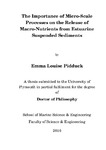The Importance of Micro-Scale Processes on the Release of Macro-Nutrients from Estuarine Suspended Sediments
| dc.contributor.supervisor | Manning, Andrew James | |
| dc.contributor.author | Pidduck, Emma Louise | |
| dc.contributor.other | School of Biological and Marine Sciences | en_US |
| dc.date.accessioned | 2016-08-25T13:00:25Z | |
| dc.date.available | 2016-08-25T13:00:25Z | |
| dc.date.issued | 2016 | |
| dc.date.issued | 2016 | |
| dc.identifier | 10041393 | en_US |
| dc.identifier.uri | http://hdl.handle.net/10026.1/5378 | |
| dc.description.abstract |
The quality of water within an estuary is inseparable from the component parts; suspended particulate matter (SPM) and the balance of macro-nutrients. Long-term temporal variations and the horizontal advection of both SPM and macro-nutrient concentrations are well-constrained, but the vertical fluxes associated with micro-scale processes, such as turbulence and flocculation, are poorly constrained. The importance of three micro-scale processes on the interactions between SPM and inorganic macro-nutrients, nitrate (NO–3 ), ammonium (NH+4) and phosphate (PO3 –4 ), are examined in four field campaigns and five laboratory experiments. Field campaigns were conducted in two turbid estuaries. One field campaign was conducted in the Seine estuary, France, and three campaigns in the Tamar estuary, U.K., in order to consider the effects of seasonal variations (spring, summer and autumn). Physical conditions measured included current velocity, turbidity, turbulence and particle size, were recorded using a suite of oceanographic instrumentation. Five different laboratory studies were conducted using the same mini annular flume, with different background conditions. Inorganic macro-nutrients were measured spectrophotometrically on a continuous flow analyser (for NO – 3 and PO3 –4) and fluorimetry (NH +4). Three hypotheses are presented as potential mechanisms controlling the release and uptake of macro-nutrients from sediments. Mechanism One (M1) described an exchange process between inorganic macro-nutrients and flocculation/disaggregating particles. It was hypothesised that flocculating particles would decrease water column macro-nutrient concentrations, and vice versa. In this study, flocculation was observed in both field sites, but there was no significant relationship between flocculation and macro-nutrient concentration. Similarly, the five laboratory studies demonstrated no statistically significant relationships between flocculation and macro-nutrient concentrations. Mechanism Two (M2) hypothesised that turbulence would enhance the release portion of the exchange processes described in M1. Furthermore, it was proposed that increased turbulence would break bonds between macro-nutrients and the surface of particle faces. Turbulence was observed to limit the floc size in all experiments (both field and laboratory), but this study determined that it did not promote a significant release mechanism for inorganic macro-nutrients. However, this study observed that turbulence played a key role in the vertical distribution of PO 3 – 4 and NH +4. In both the Seine and Tamar estuaries, surface and near-bed concentrations were observed to be statistically significantly different (p = <0.05). Finally, Mechanism Three (M3) hypothesised that increased salinity provides additional salt water cations that would enhance flocculation and M1. This study measured an increase in floc size with increasing salinity in but did not enhance the proposed M1. Instead, as with turbulence, differences in water density as a result of the salinity affected the vertical distribution of NO –3. This research concluded that micro-scale processes have no significant impact on the water-column concentration of inorganic macronutrients. Instead, it was observed that two of the three micro-scale processes, turbulence and salinity, play a key role in the vertical distribution of inorganic macro-nutrients in the Tamar and Seine estuaries. | en_US |
| dc.description.sponsorship | NERC | en_US |
| dc.language.iso | en | en_US |
| dc.publisher | Plymouth University | en_US |
| dc.subject | Estuary | en_US |
| dc.subject | Geochemistry | en_US |
| dc.subject | Flocculation | en_US |
| dc.subject | Sediment | en_US |
| dc.subject | Turbulence | en_US |
| dc.title | The Importance of Micro-Scale Processes on the Release of Macro-Nutrients from Estuarine Suspended Sediments | en_US |
| dc.type | Thesis | |
| plymouth.version | Full version | en_US |
| dc.identifier.doi | http://dx.doi.org/10.24382/3302 |
Files in this item
This item appears in the following Collection(s)
-
01 Research Theses Main Collection
Research Theses Main


